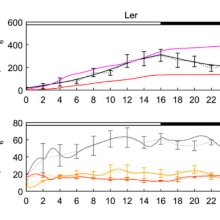We developed a mathematical model to simulate dynamics of central carbon metabolism over complete diurnal cycles for leaves of Arabidopsis thaliana exposed to either normal (120 µmol m−2 s−1) or high light intensities (1200 µmol m−2 s−1). The main objective was to obtain a high-resolution time series for metabolite dynamics as well as for shoot structural carbon formation (compounds with long residence time) and assimilate export of aerial organs to the sink tissue. Model development comprised a stepwise increment of complexity to finally approach the in vivo situation. The correct allocation of assimilates to either sink export or shoot structural carbon formation was a central goal of model development. Diurnal gain of structural carbon was calculated based on the daily increment in total photosynthetic carbon fixation, and this was the only parameter for structural carbon formation implemented in the model. Simulations of the dynamics of central metabolite pools revealed that shoot structural carbon formation occurred solely during the light phase but not during the night. The model allowed simulation of shoot structural carbon formation as a function of central leaf carbon metabolism under different environmental conditions without structural modifications. Model simulations were performed for the accession Landsberg erecta (Ler) and its hexokinase null-mutant gin2-1. This mutant displays a slow growth phenotype especially at increasing light intensities. Comparison of simulations revealed that the retarded shoot growth in the mutant resulted from an increased assimilate transport to sink organs. Due to its central function in sucrose cycling and sugar signaling, our findings suggest an important role of hexokinase-1 for carbon allocation to either shoot growth or assimilate export.


